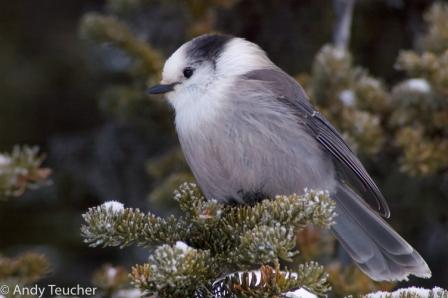
BC Conservation Data Centre: Species Summary
Perisoreus canadensis
Canada Jay

| Scientific Name: | Perisoreus canadensis (Linnaeus, 1766) | ||||||||||
|---|---|---|---|---|---|---|---|---|---|---|---|
| English Name: | Canada Jay | ||||||||||
| English Name Synonyms: |
Gray Jay
|
||||||||||
| Classification / Taxonomy | |||||||||||
| Scientific Name - Concept Reference: | American Ornithologists' Union (AOU). 1998. Check-list of North American birds. Seventh edition. American Ornithologists' Union, Washington, D.C. [as modified by subsequent supplements and corrections published in The Auk]. Also available online: http://www.aou.org/. | ||||||||||
| Classification Level: | Species | ||||||||||
| Species Group: | Vertebrate Animal | ||||||||||
| Species Code: | B-GRJA | ||||||||||
|
|||||||||||
| Conservation Status / Legal Designation | |||||||||||
| Global Status: | G5 (Apr 2016) | ||||||||||
| Provincial Status: | S5 (Mar 2015) | ||||||||||
| BC List: | Yellow | ||||||||||
| Provincial FRPA list: | |||||||||||
| Provincial Wildlife Act: | |||||||||||
| COSEWIC Status: | |||||||||||
| SARA Schedule: | |||||||||||
| General Status Canada: | 4 - Secure (2005) | ||||||||||
| Migratory Bird Convention Act: | |||||||||||
| Ecology & Life History | |||||||||||
| General Description: | |||||||||||
| Global Reproduction Comments: | Clutch size 2-5 (usually 3-4). Incubation 16-18 days, by female. Young tended by both adults, capable of first flight when about 15 days old. In Ontario and Quebec, broods broke up in June, when the young were 55-65 days old; dominant brood member expelled siblings from natal territory, shared in food stored by parents (Strickland 1991). | ||||||||||
| Global Ecology Comments: | Occupies, permanent, all-purpose territory. Usually seen in small family groups or in pairs. Gray Jays have home ranges of about 65-130 hectares in Ontario (Rutter 1969). | ||||||||||
| Migration Characteristics: (Global / Provincial) | |||||||||||
|
Nonmigrant: Local Migrant: Distant Migrant: Within Borders Migrant: |
Y / N / N / na / |
||||||||||
| Habitats: (Type / Subtype / Dependence) |
|||||||||||
| Global Habitat Comments: | Coniferous and mixed coniferous-deciduous forest (primarily spruce), including open and partly open woodland and around bogs (AOU 1983). Often around campgrounds. BREEDING: Usually nests in a conifer, 1-9 m (usually 2-3 m) above ground. | ||||||||||
| Food Habits: |
Carnivore: Adult, Immature
Frugivore: Adult, Immature Granivore: Adult, Immature Invertivore: Adult, Immature |
||||||||||
| Global Food Habits Comments: | Omnivorous. Feeds on insects, berries, lichen, mice, carrion, scraps from campsites. Probably eats birds' eggs. Stores hundreds of food items per day during summer; apparently relies heavily on that food in winter; food is cached (scatter-hoarded) in arboreal sites such as under a flake of bark, in a clump of lichen, or in a conifer needle-cluster (Condor 94:995-998). | ||||||||||
| Global Phenology: |
Diurnal: Adult, Immature
|
||||||||||
| Provincial Phenology: (1st half of month/ 2nd half of month) |
|||||||||||
| Colonial Breeder: | N | ||||||||||
| Length(cm)/width(cm)/Weight(g): | 29/ / 71 | ||||||||||
| Elevation (m) (min / max): |
Global:
Provincial: |
||||||||||
| Distribution | |||||||||||
| Endemic: | N | ||||||||||
| Global Range Comment: | BREEDING: western and central Alaska across Canada and south to northern California, eastern Oregon, Idaho, Utah, eastern Arizona, northern New Mexico, Colorado, southwestern South Dakota, northern Minnesota, northern Wisconsin, northern Michigan, northern New York, and northern New England. NON-BREEDING: mainly through breeding range (AOU 1983). | ||||||||||
| Authors / Contributors | |||||||||||
| Global Information Author: | HAMMERSON, G., REVISIONS BY S. CANNINGS | ||||||||||
| Last Updated: | Dec 30, 1993 | ||||||||||
| Provincial Information Author: | |||||||||||
| Last Updated: | |||||||||||
| References and Related Literature | |||||||||||
American Ornithologists' Union (AOU). 1983. Check-list of North American Birds, 6th edition. Allen Press, Inc., Lawrence, Kansas. 877 pp. |
|||||||||||
Campbell, R.W., N.K. Dawe, I. McTaggart-Cowan, J.M. Cooper, G.W. Kaiser, M.C.E. McNall and G.E.J. Smith 1997. The Birds of British Columbia, Vol. 3, Passerines: Flycatchers through Vireos. UBC Press in cooperation with Environ. Can., Can. Wildl. Serv. and B.C. Minist. Environ., Lands and Parks, Wildl. Branch. 700pp. |
|||||||||||
Godfrey, W.E. 1966. The birds of Canada. National Museums of Canada. Ottawa. 428 pp. |
|||||||||||
Goodwin, D. 1986. Crows of the world. Second edition. Univ. Washington Press. 300 pp. |
|||||||||||
Ham, J. C., and P. N. Lehner. 1990. Notes on gray jay demographics in Colorado. Wilson Bull. 102:698-702. |
|||||||||||
Harrison, C. 1978. A Field Guide to the Nests, Eggs and Nestlings of North American Birds. Collins, Cleveland, Ohio. |
|||||||||||
National Geographic Society (NGS). 1983. Field guide to the birds of North America. National Geographic Society, Washington, DC. |
|||||||||||
Rutter, R. J. 1969. A contribution to the biology of the Gray Jay (PERISOREUS CANADENSIS). Canadian Field-Naturalist 83:300-316. |
|||||||||||
Strickland, D. 1991. Juvenile dispersal in gray jays: dominant brood member expels siblings from natal territory. Can. J. Zool. 69:2935-2945. |
|||||||||||
Terres, J. K. 1980. The Audubon Society encyclopedia of North American birds. Alfred A. Knopf, New York. |
|||||||||||
Please visit the website Conservation Status Ranks for definitions of the data fields used in this summary report.
Suggested Citation:
B.C. Conservation Data Centre. 1993. Species Summary: Perisoreus canadensis. B.C. Minist. of Environment. Available: https://a100.gov.bc.ca/pub/eswp/ (accessed Oct 16, 2025).